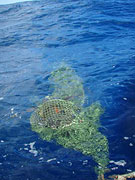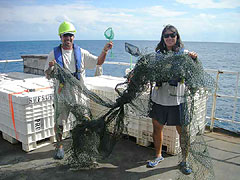

 | |||||||
|
|
Journals 2007/2008Heather Judkins
November 13, 2007 In the past few days, we have rescued 2 birds and a sea turtle while out here. First the birds... Two days ago, there was a small Leach's Storm Petrel found in a coffer dam on the ship. It had oil that covered its feathers that was in the dam. Sophie, a senior birder on board, gave it a bath, dried its feathers and released it off the fantail. That was one. Last night, Dawn, another scientist on board, found another Leach's storm petrel on the foredeck. This one didn't have oil covering its wings and seemed to be in good shape. I got to hold it while checking it out firsthand. I have seen them flying by the ship, not close up! It was a small bird, similar to the size of terns on the Gulf coast of Florida. It has webbed toes, a salt gland at the base of the beak, and small holes behind the eyes under the feathers for ears. I have never seen birds' ears before and it surprised me! They are literally holes on the sides of their little heads! Dawn also released this bird off the fantail last night. The reason we are finding them? They are attracted to the lights of the ship and sometimes stun themselves as they hit the lights or the ship. They also need places to rest while out at sea, so the ship also acts as a rest stop. The marine mammal observers spotted an Olive Ridley Sea turtle that was entangled in fishing nets. The decision was made to launch the workboat to rescue the turtle. The rescue team and workboat crew were ready to go within 5 minutes or so and away they went! Everyone else was up on the flying bridge with binoculars to watch the action. They successfully hauled the turtle in to the boat, cut the nets, and took pictures of the animal for identification purposes. They slid the animal back into the ocean and away it went! It was in great condition and swam away quickly. I have been seeing 2 to 3 turtles swim by a day as we move along our transect line. The pictures are from one of the scientists on the rescue team, Suzanne Yin. She and Juan Carlos, another scientist, are holding the net for an idea of how large it was. I am surprised at the number of entangled turtles and drift nets we have found so far. In the 8 days that I have been here, we have found 2 drift nets, an entangled turtle and one that couldn't be saved. I am 250 miles off the coast!   Marine Science Questions: 1. What is a coffer dam? How would you describe the foredeck? 2. Where are Leach's storm petrels found worldwide? Where are their breeding grounds? |
||||||